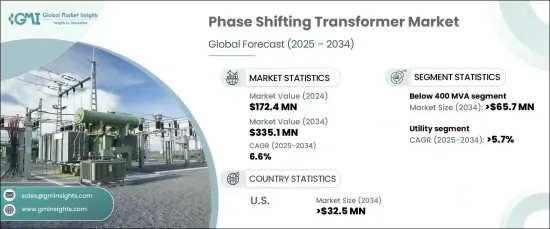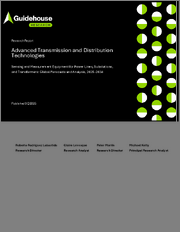
|
시장보고서
상품코드
1667048
위상변환 변압기 시장 기회, 성장 촉진요인, 산업 동향 분석, 예측(2025-2034년)Phase Shifting Transformer Market Opportunity, Growth Drivers, Industry Trend Analysis, and Forecast 2025 - 2034 |
||||||
전 세계 위상변환 변압기 시장은 2024년 1억 7,240만 달러로 평가되며, 2025년부터 2034년까지 연평균 6.6%의 안정적인 성장세를 보일 것으로 예상됩니다. 이러한 성장은 풍력 및 태양광발전과 같은 재생에너지에 대한 의존도가 높아진 것이 주요 요인으로 작용하고 있습니다. 이러한 에너지원이 확산됨에 따라 간헐적인 특성으로 인해 전력망 안정성에 문제가 발생하고 있으며, PST는 서로 다른 전력망 구간의 전력 흐름을 관리하고, 혼잡을 완화하고, 전압 레벨을 안정화하기 위해 필수적입니다. 따라서 전력망 인프라를 현대화하는 데 필수적인 역할을 하고 있습니다. 노후화된 전력망 시스템은 시급한 업그레이드가 필요하며, 많은 지역에서 산업화가 가속화됨에 따라 PST에 대한 수요는 계속 증가하고 있습니다. 이러한 변압기는 배전망의 효율성과 신뢰성을 보장하기 위해 필수적이며, 특히 재생에너지 기반의 에너지 믹스로 전환하는 지역에서는 더욱 중요합니다. 전력 수요가 증가하고 송전망이 복잡해짐에 따라 PST와 같은 첨단 전력 관리 시스템의 필요성이 더욱 커지고 있습니다.

PST 시장의 400MVA 미만 부문은 2034년까지 6,570만 달러에 달할 것으로 예상되며, 400MVA 미만의 소형 PST는 특히 인구 밀도가 높은 도시 지역에서 배전망의 유연성과 안정성을 향상시키는 역할을 하기 때문에 인기를 끌고 있습니다. 지역 송전망이 전력 수요 증가에 직면하고 있는 가운데, 이러한 소형 변압기를 도입함으로써 전력회사는 배전 균형을 보다 효과적으로 조정하고 안정적인 전압 수준을 유지할 수 있습니다. 이 변압기는 송전망의 과부하를 방지하고 도시 주민들에게 전력 공급의 신뢰성과 안정성을 보장하는 데 중요한 역할을 합니다.
| 시장 범위 | |
|---|---|
| 시작 연도 | 2024년 |
| 예측 연도 | 2025-2034년 |
| 시작 금액 | 1억 7,240만 달러 |
| 예상 금액 | 3억 3,510만 달러 |
| CAGR | 6.6% |
PST 시장은 2034년까지 CAGR 5.7%로 성장할 것으로 예상되며, 유틸리티 부문이 크게 확대될 것으로 예상됩니다. 유틸리티 규모의 위상 변환 변압기는 전체 송전선로에서 대규모 전력 흐름을 제어하는 데 필수적입니다. 이러한 변압기는 혼잡을 방지하고, 부하 불균형을 관리하고, 전체 송전망의 안정성을 보장하는 데 매우 중요합니다. 송전망이 복잡해지고 에너지 수요가 증가함에 따라 PST는 전력회사에 전력 수요와 공급의 변동에 적응할 수 있는 유연성을 제공합니다. 출력이 변동하는 것으로 알려진 재생에너지원의 통합은 전력망을 안정화하고 전력 공급의 변동성을 평준화하며 일관된 에너지 분배를 보장하기 위해 이러한 변압기의 필요성을 더욱 증가시키고 있습니다.
미국에서는 PST 시장이 2034년까지 3,250만 달러에 달할 것으로 예상됩니다. 미국 전력망의 대부분이 노후화됨에 따라 전력회사는 전력망 현대화를 우선순위로 삼고 있습니다. 위상 변환 변압기는 전력 흐름의 제어를 강화하고, 전력망의 병목 현상을 줄이며, 전력 시스템의 신뢰성을 향상시키는 등 이러한 전환에 중요한 역할을 하고 있습니다. 재생에너지가 미국 에너지 믹스에서 차지하는 비중이 계속 증가함에 따라 PST는 전력망 운영을 최적화하고 탄력적이고 적응력 있는 전력망이라는 미국의 목표를 달성하기 위해 점점 더 필수적인 요소가 되고 있습니다.
목차
제1장 조사 방법과 조사 범위
- 시장 정의
- 기본 추정과 계산
- 예측 계산
- 데이터 소스
- 1차 데이터
- 2차 데이터
- 유료
- 공개
제2장 주요 요약
제3장 업계 인사이트
- 생태계 분석
- 규제 상황
- 업계에 대한 영향요인
- 성장 촉진요인
- 업계의 잠재적 리스크와 과제
- 성장 가능성 분석
- Porters 분석
- 공급 기업의 교섭력
- 구매자의 교섭력
- 신규 참여업체의 위협
- 대체품의 위협
- PESTEL 분석
제4장 경쟁 구도
- 전략 대시보드
- 혁신과 지속가능성 전망
제5장 시장 규모 및 예측 : 격 부별, 2021-2034년
- 주요 동향
- 400 MVA 미만
- 400 MVA-800 MVA
- 800 MVA 이상
제6장 시장 규모 및 예측 : 용도별, 2021-2034년
- 주요 동향
- 산업용
- 유틸리티
- 기타
제7장 시장 규모 및 예측 : 지역별, 2021-2034년
- 주요 동향
- 북미
- 미국
- 캐나다
- 멕시코
- 유럽
- 영국
- 프랑스
- 독일
- 이탈리아
- 러시아
- 스페인
- 아시아태평양
- 중국
- 호주
- 인도
- 일본
- 한국
- 중동 및 아프리카
- 사우디아라비아
- 아랍에미리트
- 터키
- 남아프리카공화국
- 이집트
- 라틴아메리카
- 브라질
- 아르헨티나
제8장 기업 개요
- ABB
- Eaton
- GE Grid Solutions
- Hitachi Energy
- Hyosung Heavy Industries
- Schneider Electric
- SGB-SMIT Group
- Siemens Energy
- Tamini Transformers
- Toshiba International Corporation
- Wilson Transformers
The Global Phase Shifting Transformer Market, valued at USD 172.4 million in 2024, is set to grow at a steady CAGR of 6.6% from 2025 to 2034. This growth can be largely attributed to the increasing reliance on renewable energy sources such as wind and solar power. As these energy sources become more prevalent, they introduce challenges in grid stability due to their intermittent nature. PSTs are vital for managing power flows across different grid sections, alleviating congestion, and stabilizing voltage levels. This makes them indispensable in modernizing the electrical grid infrastructure. With aging grid systems in need of urgent upgrades and industrialization ramping up in many regions, the demand for PSTs continues to rise. These transformers are essential for ensuring the efficiency and reliability of power distribution networks, particularly in regions transitioning to a more renewable-based energy mix. As the demand for electricity rises and grid complexities increase, the need for advanced power management systems like PSTs becomes even more pressing.

The below 400 MVA segment of the PST market is anticipated to generate USD 65.7 million by 2034. Smaller PSTs, below 400 MVA, are gaining traction due to their role in enhancing the flexibility and stability of distribution grids, especially in urban areas with high population density. As local grids face increased electricity demand, the deployment of these smaller transformers allows utilities to balance power distribution more effectively and maintain stable voltage levels. These transformers play a key role in preventing grid overloads while ensuring that the power supply remains reliable and consistent for urban populations.
| Market Scope | |
|---|---|
| Start Year | 2024 |
| Forecast Year | 2025-2034 |
| Start Value | $172.4 Million |
| Forecast Value | $335.1 Million |
| CAGR | 6.6% |
The utility sector is expected to experience significant expansion in the PST market, projected to grow at a CAGR of 5.7% through 2034. Utility-scale phase-shifting transformers are indispensable for controlling large-scale power flows across transmission networks. These transformers are pivotal in preventing congestion, managing load imbalances, and ensuring overall grid stability. As electrical grids become more complex and demand for energy grows, PSTs offer utilities the flexibility to adapt to fluctuations in power supply and demand. The integration of renewable energy sources, known for their variable outputs, further drives the necessity for these transformers, which help stabilize the grid and smooth out variations in power supply, ensuring consistent energy distribution.
In the U.S., the PST market is projected to reach USD 32.5 million by 2034. With much of the U.S. electrical grid aging, utilities are prioritizing grid modernization efforts. Phase-shifting transformers are a critical part of this transition, offering enhanced control of power flows, reducing grid bottlenecks, and improving the reliability of the power system. As renewable energy continues to take a larger share of the U.S. energy mix, PSTs are becoming increasingly essential for optimizing grid operations and meeting the nation's goals for a resilient and adaptable power grid.
Table of Contents
Chapter 1 Methodology & Scope
- 1.1 Market definitions
- 1.2 Base estimates & calculations
- 1.3 Forecast calculation
- 1.4 Data sources
- 1.4.1 Primary
- 1.4.2 Secondary
- 1.4.2.1 Paid
- 1.4.2.2 Public
Chapter 2 Executive Summary
- 2.1 Industry synopsis, 2021 – 2034
Chapter 3 Industry Insights
- 3.1 Industry ecosystem analysis
- 3.2 Regulatory landscape
- 3.3 Industry impact forces
- 3.3.1 Growth drivers
- 3.3.2 Industry pitfalls & challenges
- 3.4 Growth potential analysis
- 3.5 Porter's analysis
- 3.5.1 Bargaining power of suppliers
- 3.5.2 Bargaining power of buyers
- 3.5.3 Threat of new entrants
- 3.5.4 Threat of substitutes
- 3.6 PESTEL analysis
Chapter 4 Competitive landscape, 2024
- 4.1 Strategic dashboard
- 4.2 Innovation & sustainability landscape
Chapter 5 Market Size and Forecast, By Rating, 2021 – 2034 (Units & USD Million)
- 5.1 Key trends
- 5.2 < 400 MVA
- 5.3 400 MVA - 800 MVA
- 5.4 > 800 MVA
Chapter 6 Market Size and Forecast, By Application, 2021 – 2034 (Units & USD Million)
- 6.1 Key trends
- 6.2 Industrial
- 6.3 Utility
- 6.4 Others
Chapter 7 Market Size and Forecast, By Region, 2021 – 2034 (Units & USD million)
- 7.1 Key trends
- 7.2 North America
- 7.2.1 U.S.
- 7.2.2 Canada
- 7.2.3 Mexico
- 7.3 Europe
- 7.3.1 UK
- 7.3.2 France
- 7.3.3 Germany
- 7.3.4 Italy
- 7.3.5 Russia
- 7.3.6 Spain
- 7.4 Asia Pacific
- 7.4.1 China
- 7.4.2 Australia
- 7.4.3 India
- 7.4.4 Japan
- 7.4.5 South Korea
- 7.5 Middle East & Africa
- 7.5.1 Saudi Arabia
- 7.5.2 UAE
- 7.5.3 Turkey
- 7.5.4 South Africa
- 7.5.5 Egypt
- 7.6 Latin America
- 7.6.1 Brazil
- 7.6.2 Argentina
Chapter 8 Company Profiles
- 8.1 ABB
- 8.2 Eaton
- 8.3 GE Grid Solutions
- 8.4 Hitachi Energy
- 8.5 Hyosung Heavy Industries
- 8.6 Schneider Electric
- 8.7 SGB-SMIT Group
- 8.8 Siemens Energy
- 8.9 Tamini Transformers
- 8.10 Toshiba International Corporation
- 8.11 Wilson Transformers

















